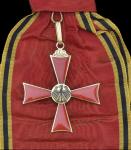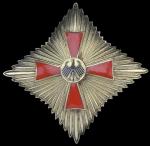-
Posts
3,944 -
Joined
-
Last visited
-
Days Won
32
Content Type
Profiles
Forums
Blogs
Gallery
Events
Store
Everything posted by Megan
-

Printed Ribbon Bars
Megan replied to JohnJArcher's topic in Great Britain: Militaria: Badges, Uniforms & Equipment
Medal maven? Yes, the OMSA has a ribbon bank (find details at http://www.omsa.org/), the OMRS also has one although it's mostly UK ribbons... they say if you are after foreign ones you need to write to Mr Alan McDonald, 5 Windsor Drive, Barnet, Hertfordshire EN4 8UE, England to see if they can supply what you want (their rather basic website is not noted for supplying useful e-mail addresses, alas). It is also worth visiting a good tailor - Moss Bros. for example - to see if they can help. -

Discussing politics and ketchup
Megan commented on Brian Wolfe's blog entry in News From the Home Office.
GRRR. You have made me feel hungry. -

Bundesrepublik "Order of Merit" : Germany
Megan replied to Elvis's topic in Germany: Post 1945: Bundesrepublik & DDR
Ralf Ganzel (Militaria Agent) has a couple of Medals of Merit, but not cased. He's also got a heap of Armed Forces Deployment Medals (Einzatzmedaille der Bundeswehr) with different clasps (mostly cased) and a full set of Honour Crosses (Ehrenkreuz) also mostly cased, if you are interested. He, kind soul, is one of those who allows me to use images from his catalogue so I have lots to work on from there! https://www.militaria-agent.com/ -
The quality of the original image misled me then... This is the post-2008 version of the Order of the Volta, they changed the ribbon colour from a dark blue with red edges and black central stripe to the one shown (light blue with green, yellow and red edges). The highest grade, worn as a sash badge, is the Companion, the other grades being Officer and Member. It's a bit unusual, the Companion has a sash badge but no star... and quite often they are seen wearing a neck badge at the same time!
-
It's the Central African Republic Order of Recognition, Officer - the higher of the 2 classes awarded. Instituted on 2 May 1962 it's awarded for services to the nation.
-

Bundesrepublik Dr Viktor von Zahn-Stranik
Megan replied to Herr General's topic in Germany: Post 1945: Bundesrepublik & DDR
Quite an array there... Neck badges: German Order of Merit - possibly Grand Merit Cross (Großes Verdienstkreuz des Verdienstordens) given the lack of a star from this order amidst the array (he may just have run out of space!) and the Italian Order of Merit. Stars: Sweden Order of the Northern Star Commander 1st Class, Spain Order of Isabella the Catholic, Portugal Order of Christ, Portugal Order of Prince Henry the Navigator, the other one will have to wait until I am at home with my references! Sash: Looks like Portugal Order of Prince Henry the Navigator. -
Thank you so much for going to the trouble of asking!
-

Bundesrepublik "Order of Merit" : Germany
Megan replied to Elvis's topic in Germany: Post 1945: Bundesrepublik & DDR
Very nice. And I too love your site, particularly as I am now working on the German section of my site... alas there are not many modern German items coming up for sale with the various dealers/auction houses which permit me to use their catalogues, so I am relying on collectors (thank you Frank!), but a few have come up like these on Dix Noonan Webb in their last (10 December 2014) auction: Großes Verdienstkreuz mit Stern und Schulterband if I am not mistaken. The search continues... but at least I know what I am looking for after consulting your site, Uwe. -

Falklands Medal Rosette
Megan replied to Wilhelmina's topic in Great Britain: Orders, Gallantry, Campaign Medals
Firstly, a big welcome to another lady! As for the rosette, it's quite unusual. A rosette is normally used to indicate the award of a clasp or the second award of a decoration (indicated on the full medal by a bar) when 'ribbons only' are worn, for example on service dress. With the South Atlantic Medal the rosette is worn on the full medal itself and is the award. Now, the South Atlantic Medal was awarded for involvement in the Falklands War, the rosette itself was awarded for 1 day's service or 1 operational sortie within the area of 35o to 60o south. Naturally most people involved were physically present (in ships, yomping around and so on) and so qualified for the rosette along with the medal. -
That's beautiful... any chance you'd permit me to use that on my website?
-

Russian Federation Commemorative Badge "100 Years of Air Defense"
Megan replied to TacHel's topic in Russian Federation
Just as well my Christmas break is coming up... -

Russian Federation 6 new Defense Ministry medals
Megan replied to TacHel's topic in Russian Federation
These seem to be more 'sporting awards' than proper medals. The real test is, do they have a ribbon bar and can they be worn in uniform after the award ceremony at the end of the contest. -

Winston Churchill, From Scapegoat to Hero
Megan commented on Brian Wolfe's blog entry in News From the Home Office.
I read Churchill's History of WW2 when quite young (late teens, I think). The first volume was very self-serving, but it improved later on once it was dealing with the actual war and included other people who contributed to the war effort. -

Russian Federation 6 new Defense Ministry medals
Megan replied to TacHel's topic in Russian Federation
Of course, or at least there is the "Medal for the Return of the Crimea"... instituted 25 March 2014. -

Russian Federation 6 new Defense Ministry medals
Megan replied to TacHel's topic in Russian Federation
Waaah.... -
Just in case you meet a passing riot, this is what you have to say: "Our Sovereign Lord the King chargeth and commandeth all persons, being assembled, immediately to disperse themselves, and peaceably to depart to their habitations, or to their lawful business, upon the pains contained in the act made in the first year of King George, for preventing tumults and riotous assemblies. God Save the King!" (I learned this in the early 1980s when working in a school... it stopped playground fights even if the kids were more puzzled than anything else!)
-

Denmark Danish Medal Collection
Megan replied to Mervyn Mitton's topic in Northern European & Baltic States
For those who like the images, they are now on Invaluable: http://www.invaluable.com/catalog/searchLots.cfm?scp=c&catalogRef=WICICSW2FJ -

Denmark Danish Medal Collection
Megan replied to Mervyn Mitton's topic in Northern European & Baltic States
By the way, the print catalogue arrived a couple of days ago - many thanks, Paul - really appreciated! -

Denmark Danish Medal Collection
Megan replied to Mervyn Mitton's topic in Northern European & Baltic States
Grrr. It's really annoying as I have been looking for pictures of those for ages and now some come along which I can use (Morton & Eden are kind enough to permit me to use their images on my site, you see)... they turn out to be fakes Thanks for the masterclass on what to look out for, Michael. -

Denmark Danish Medal Collection
Megan replied to Mervyn Mitton's topic in Northern European & Baltic States
Ooooh... lovely Will there be pictures on Invaluable in due course? -

Neville Chamberlain a Maligned Hero
Megan commented on Brian Wolfe's blog entry in News From the Home Office.
The key phrase is "tasked to carry out the will of the people" - whilst politicians may have ideas and should attempt to convince the electorate of their merits, they are hired to act on citizens' behalf. What did the citizens of the UK want during the 1930s? History is always blighted by hindsight. We know what was to come and it is easy to say that things should have been done differently. Good historians dig down to find out what was known at the time and to whom, and what the 'will of the people' was... Did Chamberlain do what the citizens of the UK wished him to do, based on the information he and they had? -

Bundesrepublik Saxon Merite Order
Megan replied to Red Eagle's topic in Germany: Post 1945: Bundesrepublik & DDR
It is indeed, thank you for sharing.





